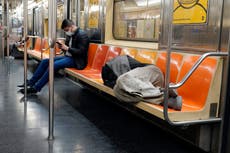Platform barriers are coming to New York subway stations after spate of fatal attacks
‘Months ago, I started seeing that the number of people getting on the tracks and in the tunnels was going up,’ says MTA chairman Janno Lieber. ‘So I created an interagency group at the MTA to study it’
New York’s subway system will test out platform barriers at three stations, a month after a passenger was pushed to her death on the tracks.
The agency that runs the subway, the Metropolitan Transportation Authority, has resisted the dividers for years, calling them expensive and impractical for the century-old system. But after the grisly death of Michelle Go, as well as several other recent incidents in which commuters have been pushed onto the rails, the MTA has finally decided to give the platform-edge barriers a try.
“Months ago, I started seeing that the number of people getting on the tracks and in the tunnels was going up,” MTA chairman Janno Lieber told NY1. “There’s been a significant increase. So I created an interagency group at the MTA to study it.”
The pilot program will bring barriers to the stations at Times Square, Third Avenue, and Sutphin Boulevard, where passengers transfer to the AirTrain to JFK Airport. Mr Lieber did not say when the barriers would be built.
Subway systems all over the world, including many in Asia and Europe, already feature glass dividers on their platforms, with gates that open in the same place as the train doors to allow passengers on and off. In fact, New York’s AirTrain already has them.
But the city’s famously no-frills subway, which first opened in 1904, has nothing at the edge of its platforms to stop commuters from falling into the tracks.
That lack of safety infrastructure has become especially dangerous in recent months, as violent crime on the system has surged. According to the New York Daily News, 2021 saw the highest number of assaults on the subway since 1997. The number of people pushed onto the tracks has also risen, from 20 in 2019 to 30 in 2021 – even as the total number of riders plummeted amid the pandemic.
And the city is still on edge since the death of Ms Go, a 40-year-old woman who was pushed into an oncoming R train by a homeless man at Times Square. Just eight days after that horrific incident, a 61-year-old man was also pushed onto the tracks, though he survived.
New York’s new mayor, Eric Adams, has pledged to get the situation under control.
“We’re going to drive down crime and make sure New Yorkers feel safe in the subway system,” Mr Adams said last month. “And they don’t feel that way now.”
Join our commenting forum
Join thought-provoking conversations, follow other Independent readers and see their replies
Comments




Bookmark popover
Removed from bookmarks